For generations, our tax dollars have served as shared investments in the programs and services that make our state a great place to live, work, and play.Tax dollars enable Montanans to work together for those things which we could not achieve alone, like educating our children, building infrastructure, keeping our air and water clean, and paving the way to a strong economy for everyone.
In Montana, these shared investments are managed through the state’s General Fund. Taxes make up the vast majority of the revenue for the General Fund, and the individual income tax is the single largest source of revenue, comprising nearly 60 percent of the state’s General Fund revenue.[1]
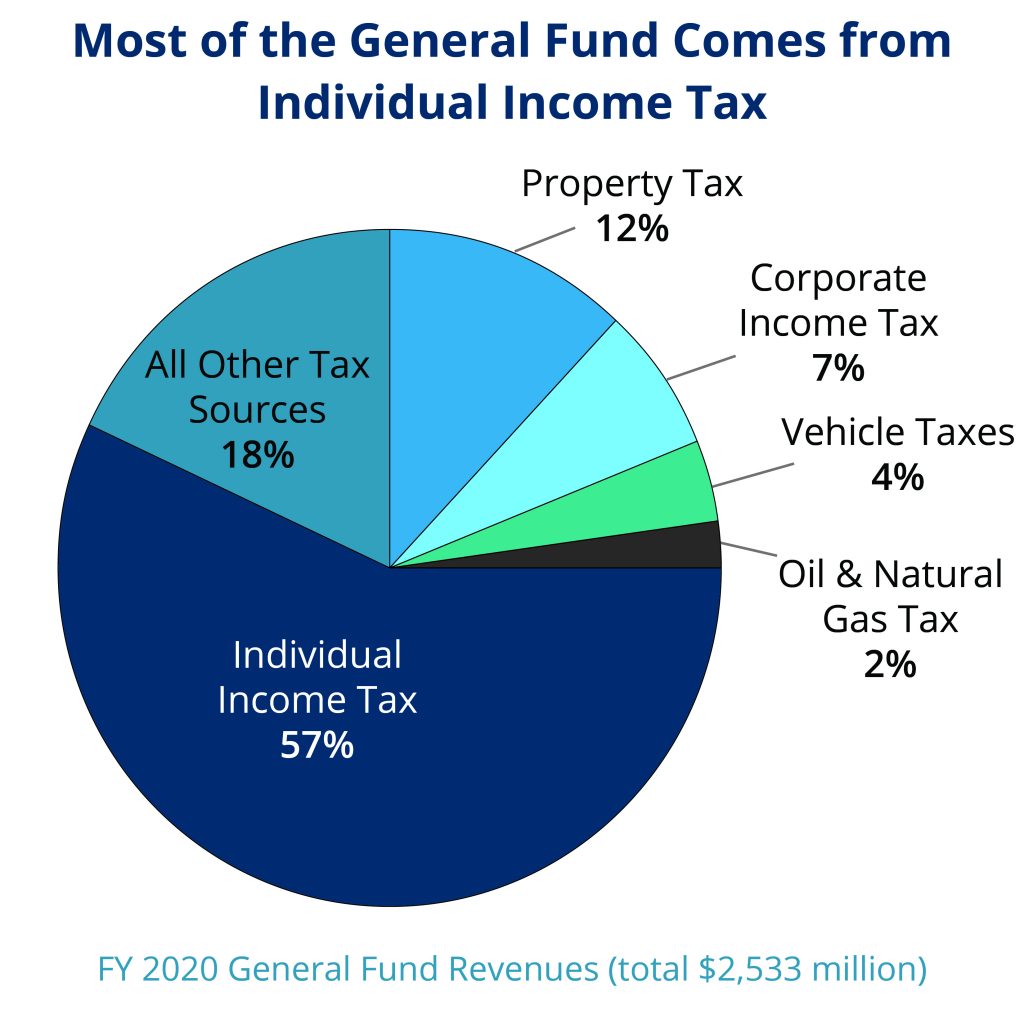
Wages and salaries make up almost two-thirds of income subject to individual income tax.[2] In general, taxes paid by corporations are paid through the corporate income tax. However, depending on how the entity is structured, business income may be reported through the individual income tax.
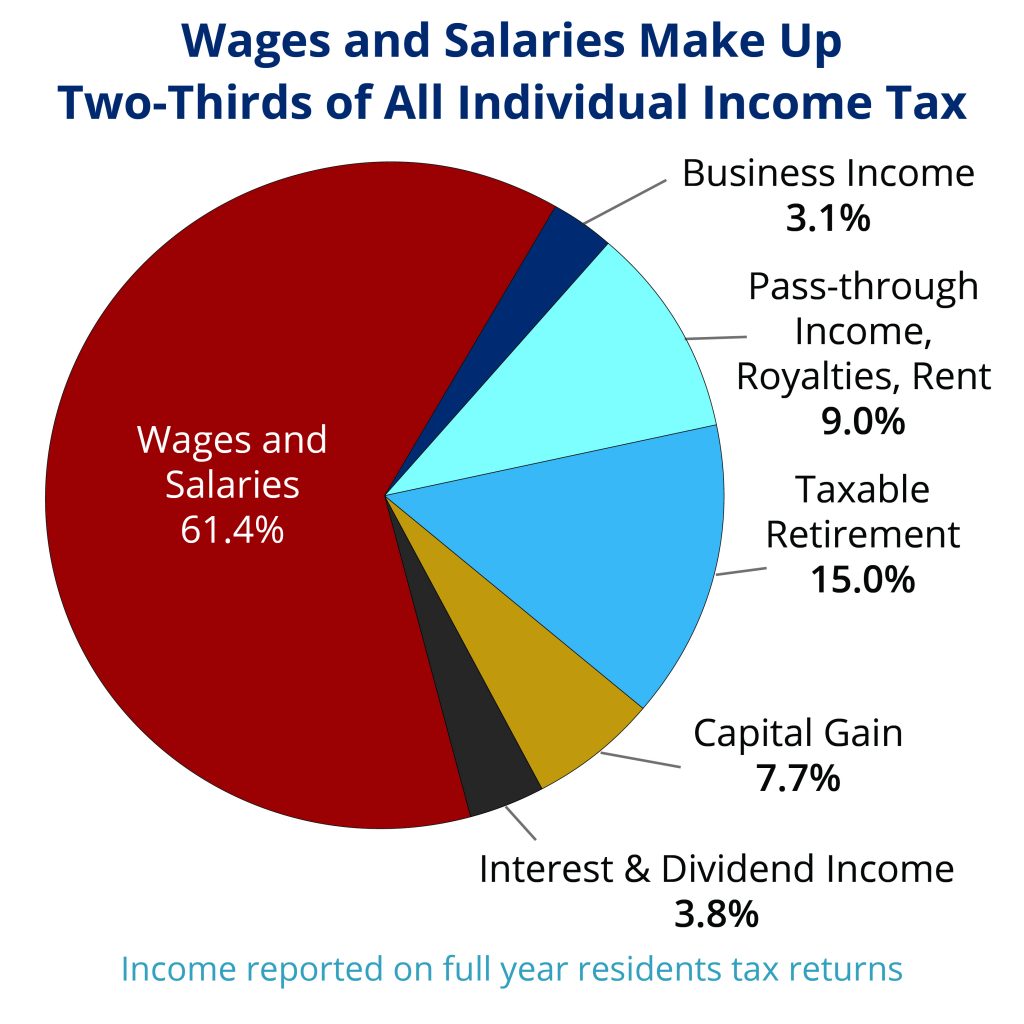
Specifically, if the business is structured as a C-corporation in order to receive the legal benefits associated with such a status, its taxes would be classified as corporate income taxes. All other businesses, including sole proprietorships, partnerships, limited liability corporations, and S-corporations, report income on individual returns, and this amount is reflected in both pass-through income and business income, which comprises less than 13 percent of total individual income.[3]
In 2003, the Montana Legislature made harmful changes to our income tax system. That year, legislators passed a bill that greatly altered Montana’s tax system by providing a significant tax cut for the wealthiest households.[4] The changes made in 2003 included collapsing the income tax brackets and creating a tax cut for capital gains income. Both of these provisions make our tax system more regressive, giving a greater tax cut to high-income households and costing the state nearly a billion dollars in revenue in the decade from 2005 to 2016, which could have been used to invest in our future.[5]
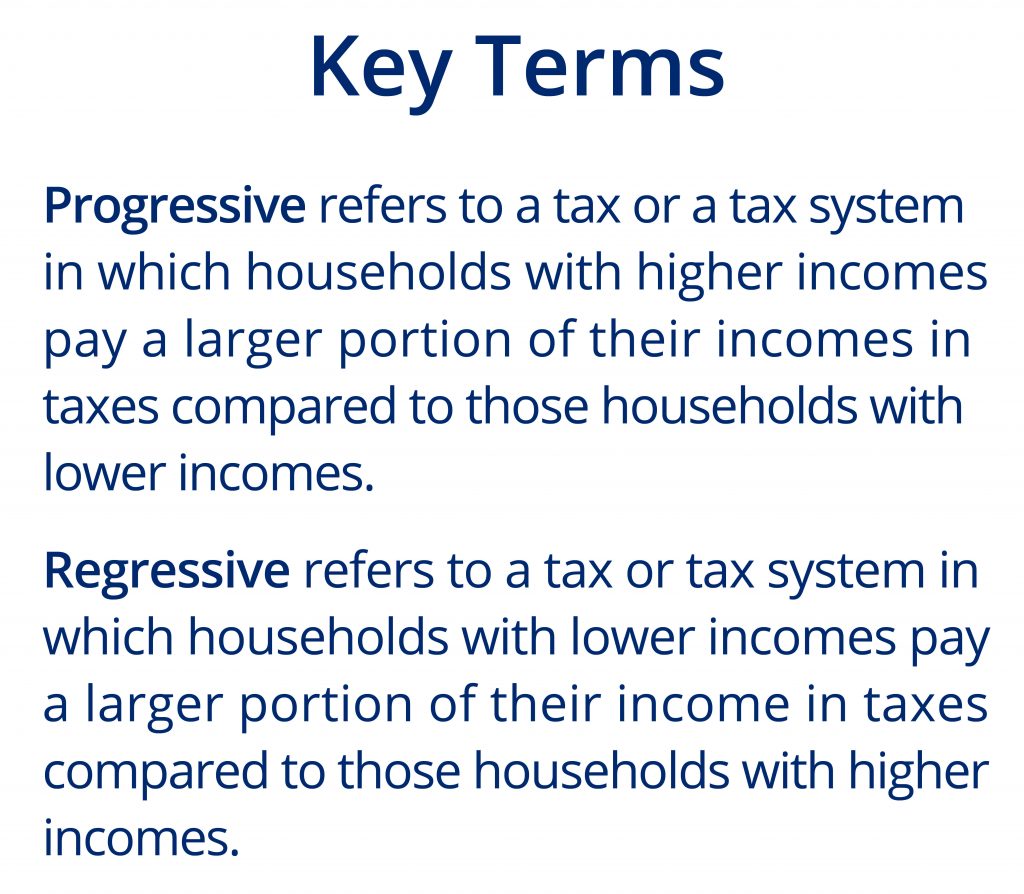
Prior to the tax cuts implemented in 2003, Montana had 10 different income brackets, with each higher income bracket paying a slightly larger share of their income in taxes.[6] In the former structure, the lowest income bracket paid 2 percent of their income in taxes, while the highest bracket (applying to incomes greater than $108,700, adjusted for 2019) paid 11 percent of that income in taxes.
The changes in 2003 reduced the total number of income brackets to seven. In 2019, the top bracket now includes all households making more than $18,400.[7] That means someone earning just above the minimum wage now faces the same top marginal tax rate as someone making $1 million. As a result of the 2003 tax cuts, the wealthiest households experienced the greatest tax reductions. Almost half (47.6 percent) of the reduction in income taxes went to households with incomes of more than $500,000, the top 0.4 percent of taxpayers, whose average tax reduction was $30,499. For the bottom 81 percent of Montana taxpayers, the average tax cut was just $23.[8]
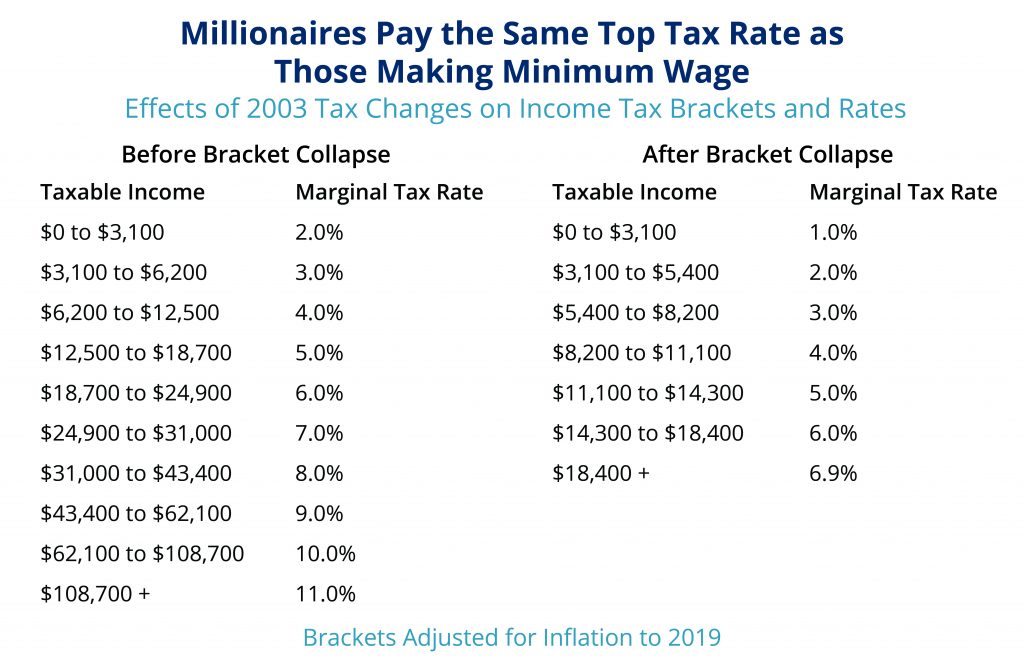
As a whole, these tax cuts have created a more regressive income tax structure. In fact, while our individual income tax remains slightly progressive, it is not progressive enough to offset the regressivity of our property taxes and selective sales and excise taxes.[9] In other words, when looking at the entire tax system in Montana, taxpayers with lower wages pay a larger portion of their income in taxes compared to those with higher incomes.
The changes have also had a negative impact on Montana’s revenue. In the first decade following the 2003 tax cuts, it is estimated that the state lost one billion dollars in revenue.[10] This lost revenue could have been used to educate our children, keep our communities safe, and protect our land and water, instead of cutting taxes for those who need it the least.
For further information about the income tax bracket collapse, see Montana Budget & Policy Center’s report, The Montana We Could Be: Tax cuts, aimed at the rich, take a toll.
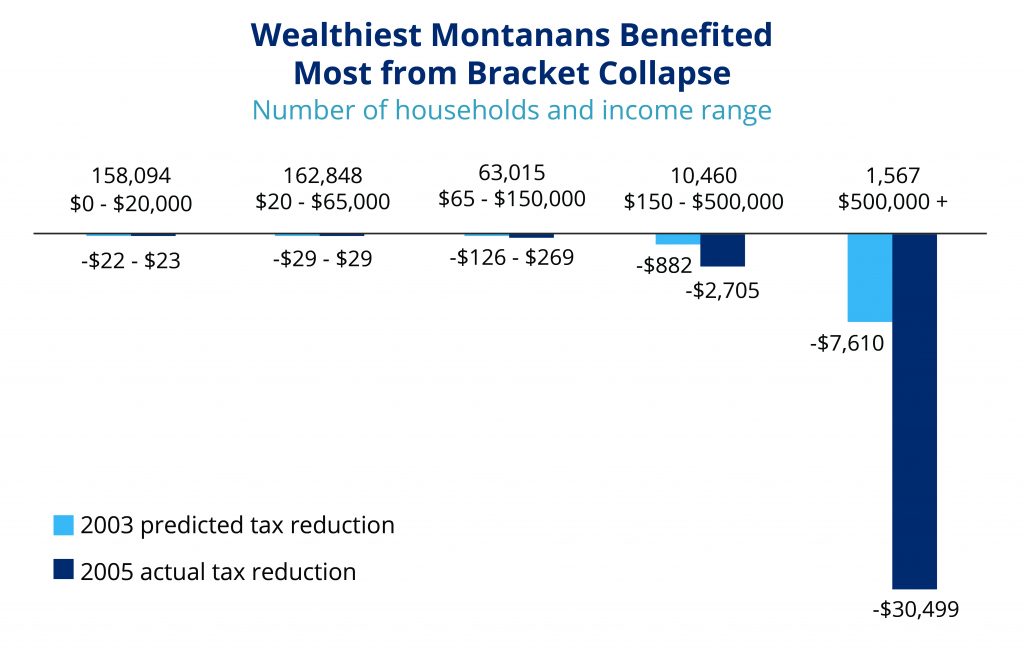
Currently, Montana is one of only nine states that offer significant tax breaks for capital gains.[11] The capital gains credit has proven to be unaffordable, is unfair to Montanans who earn income through wages, and has not benefited the Montana economy.[12]
The capital gains credit lowers the effective tax rate for people who earn income through investments compared to those who earn income from wages. This creates a tax system that favors wealth over work. In 2018, more than half of the benefits from the credit went to the wealthiest one percent of taxpayers (just 4,713 households in Montana).[13]
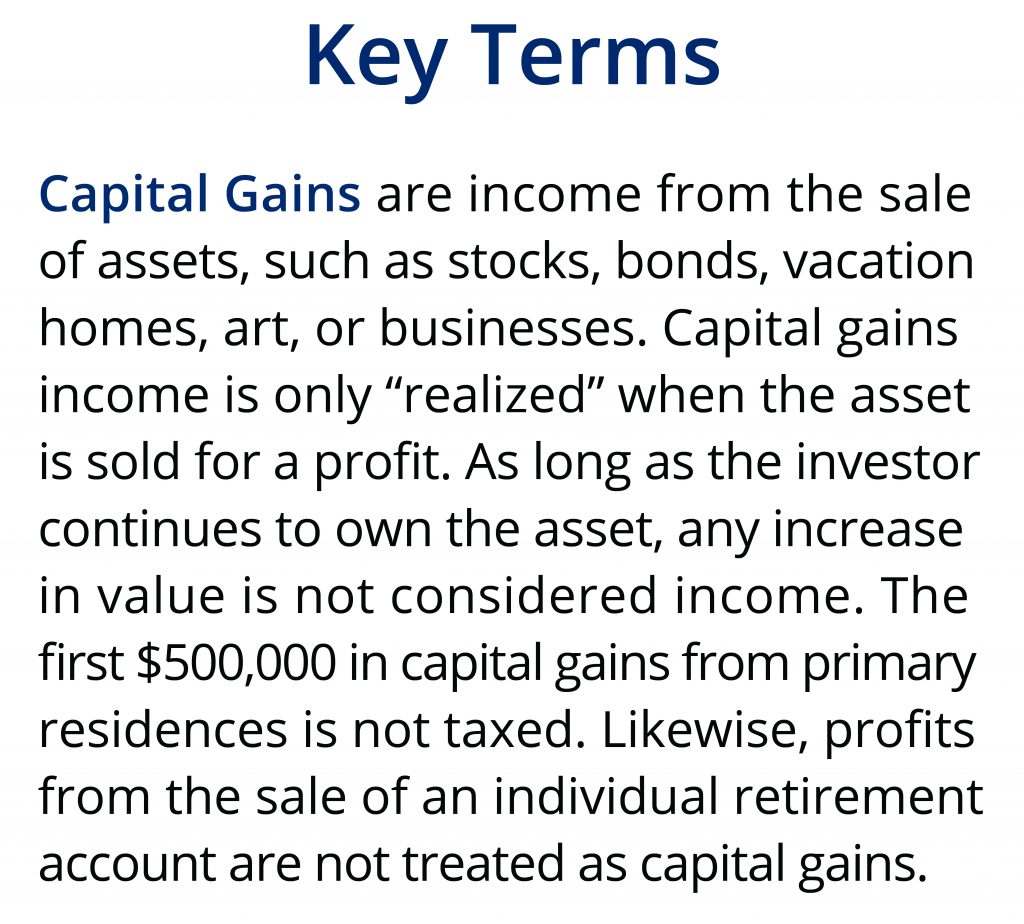
Nearly all Montanans who earn lower and middle incomes do not benefit from the credit because they are much more likely to earn their income on the job rather than through the sale of large assets. In 2017, more than 78 percent of Montana taxpayers – more than 448,000 taxpayers – did not receive any benefit from the capital gains credit.[14] In fact, the assets owned by most Montanans – primary residences and retirement funds – are not treated as capital gains income when they are sold.
Treating capital gains more favorably than wages will not help the economy. In fact, the lost tax revenue could actually prevent growth by forcing state budget cuts. The capital gains credit cost Montana more than $55 million in 2018.[15] These vital dollars could have been used to fund growth-oriented services like education, health care, and infrastructure improvements.
For more information, see MBPC’s report, Capital Gains Tax Credit: Valuing Wealth Over Work in Montana.
In 2017, the Montana Legislature passed a state earned income tax credit (EITC) making Montana the 29th state to create a state EITC to help working families make ends meet.[16] Beginning in 2019, Montana started providing a refundable tax credit set at 3 percent of the federal EITC to households working at lower wage jobs, offering a maximum benefit of $192. In tax year 2019, 71,473 Montana households received the EITC.[17]
Prior to the 2017 session, Montana required families living on poverty-level incomes to pay more in income taxes than almost all other states.[18] A state EITC is an effective tool to help people rise about poverty-level incomes by putting more money in the pockets of families to spend on groceries or catch up on bills. However, Montana can do more to improve the economic security of families living on low incomes by increasing the credit amount. Among the 29 states and District of Columbia that offer a state EITC, Montana’s 3 percent credit is the lowest.[19] Raising the value of the credit to 10 percent of the federal credit, similar to Colorado and Nebraska, would result in a maximum benefit of $666, and will go further in helping families meet their basic needs.[20]
For more information, see MBPC’s report, A State Earned Income Tax Credit: Helping Montana’s Families and Economy.
Montana is one of just six states that still has a deduction for federal income taxes paid, a deduction that disproportionately benefits the highest income earners in the state and costs the state much-needed revenue.[21] In 2017, this deduction cost $94.2 million.[22]
The deduction for federal taxes paid is an unusual tax break that allows taxpayers to deduct the federal taxes they pay from their Montana taxable income. The deduction is only available to those who utilize itemized deductions and is capped at $5,000 for a single taxpayer and $10,000 for married taxpayers filing a joint return.[23]
Eliminating this deduction would impact a little more than one-third of taxpayers overall, with more than two-thirds of the tax increase going to the top 20 percent of taxpayers. Halving the deduction from $5,000 to $2,500 per spouse would generate $27 million in revenue for the state.[24]
Generally, all individual tribal citizens are subject to federal income taxes. The exception to this is income derived directly from allotted trust lands or treaty fishing rights.[25] In Montana, tribal citizens are also subject to state income taxes if they live or work off the reservation where they are enrolled.[26] In 2019, 40 percent of American Indians resided off-reservation in Montana, and many more American Indians living on their reservation were working in nearby communities.[27]
Federally recognized tribal governments do not pay state income taxes because states cannot tax tribal nations in Indian Country.[28] Thus, federally recognized tribal nations receive the same income tax exemption as federal and state governments. However, income generated through tribal corporations chartered under state law is subject to federal and state income taxation.[29]
Tribal governments, like federal and state governments, have the right to tax the income of their own citizens, but few, if any, actually do. Each tribal nation has its own reasons stemming from its unique history and cultural views on the matter. Today, infringement upon tribal sovereignty, systemic racism and present-day discrimination play into a system of lower incomes and higher rates of unemployment on many reservations, contributing to the unfeasibility of taxing tribal citizen income. In Montana, 14 to 41 percent of reservation residents live in households with poverty-level incomes.[30] Likewise, unemployment on some reservations in the state is as high as 31.1 percent.[31]
For more information, see MBPC’s report series Policy Basics: Taxes in Indian Country Part 1: Individual Tribal Members and Policy Basics: Taxes in Indian Country Part 2: Tribal Governments.
Our income tax system is one of the primary ways that we pool our resources to make investments in public services and infrastructure that help make 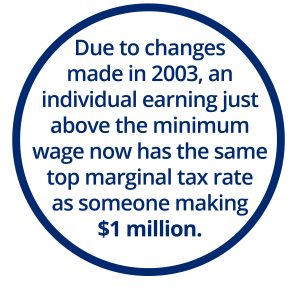 our communities stronger, safer, healthier, and more prosperous. Montana can make better choices that do not put the greatest weight on those making the least. The following reforms would greatly strengthen Montana’s income tax system:
our communities stronger, safer, healthier, and more prosperous. Montana can make better choices that do not put the greatest weight on those making the least. The following reforms would greatly strengthen Montana’s income tax system:
Montana needs a modern income tax system that makes continued investment in our communities and economy, paving the way for a more prosperous future for our children and grandchildren.

MBPC is a nonprofit organization focused on providing credible and timely research and analysis on budget, tax, and economic issues that impact low- and moderate-income Montana families.